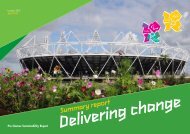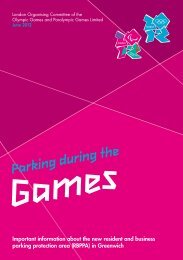Venues guide - London 2012 Olympics
Venues guide - London 2012 Olympics
Venues guide - London 2012 Olympics
You also want an ePaper? Increase the reach of your titles
YUMPU automatically turns print PDFs into web optimized ePapers that Google loves.
Accessibility Diversity<br />
Inclusive and accessible<br />
design has been at the heart<br />
of the Games.<br />
<strong>London</strong> <strong>2012</strong> wanted to set<br />
an excellent standard of<br />
accessibility for disabled<br />
people, older people and<br />
families with children, which<br />
would set a benchmark<br />
and act as an inspiration<br />
to others.<br />
The Olympic and Paralympic<br />
Village, sporting venues,<br />
new transport services,<br />
supporting facilities and the<br />
Park itself will be accessible<br />
to people with a wide range<br />
of disabilities both during<br />
and after the Games.<br />
Facts<br />
Accessibility has been<br />
improved at railway stations<br />
and public transport<br />
facilities, with £200 million<br />
invested in Stratford Station<br />
alone, providing new lifts,<br />
clearer platforms and<br />
enhanced services.<br />
The parklands have been<br />
designed with shallow<br />
gradients and seating at<br />
regular intervals so that they<br />
are accessible to everyone,<br />
including older people,<br />
disabled people and those<br />
with pushchairs.<br />
A new network of accessible<br />
transport was devised and<br />
publicised to encourage<br />
people with accessibility<br />
needs to use public transport<br />
– often for the fi rst time.<br />
Local community<br />
organisations have been<br />
consulted and <strong>London</strong> <strong>2012</strong>’s<br />
strategy has been infl uenced<br />
by the experiences of<br />
multi-faith groups, parents<br />
and disabled people.<br />
The opportunity provided<br />
by the Games and the large<br />
investment in this part of east<br />
<strong>London</strong> is helping to reduce<br />
historic and long-standing<br />
inequalities.<br />
<strong>London</strong> <strong>2012</strong> developed<br />
employment and training<br />
programmes with partner<br />
organisations and<br />
contractors to encourage<br />
women, black, Asian and<br />
minority ethnic (BAME)<br />
people, disabled people,<br />
and those who were<br />
previously unemployed to<br />
improve their skills and apply<br />
for jobs in construction and<br />
other areas where they<br />
have traditionally been<br />
underrepresented.<br />
Away from construction,<br />
programmes were also<br />
established to reduce<br />
discrimination experienced<br />
by disabled people, older<br />
people and BAME people.<br />
86 87<br />
Facts<br />
The <strong>London</strong> <strong>2012</strong> Women<br />
into Construction project was<br />
established to help women<br />
get work placements in<br />
construction, an industry in<br />
which they are traditionally<br />
underrepresented. Since the<br />
project began in 2008, 270<br />
women were recruited and<br />
placed directly into jobs on<br />
the Olympic Park through<br />
this project, exceeding its<br />
original target of 50.<br />
1,713 women worked on<br />
the major construction phase<br />
of the Olympic Park and<br />
Olympic and Paralympic<br />
Village and 5,092 of the<br />
Park and Village workers<br />
declared that they were from<br />
a BAME background.<br />
More than 1,000 community<br />
events and meetings<br />
have taken place with<br />
different faith, age, gender,<br />
disability, sexual orientation<br />
and ethnicity groups to<br />
encourage them to get<br />
involved in the Games.






